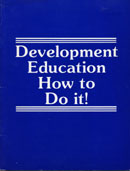
Development Education
How To Do It
Heden, Patricia
Publisher: CUSO Development Education, Ottawa, Canada
Year First Published: 1980
Year Published: 1983
Pages: 40pp Resource Type: Pamphlet
Cx Number: CX2893
Abstract:
This kit brings together the collective experience and wisdom of many development education workers in order to assist newcomers to the field. Development education is defined..."an ongoing process of reflection and action. Its purpose is to expose and work against the structures which impede human development in a way which empowers people in many sectors to take action in their own community."
The kit contains a brief history of development education in CUSO, a range of programme ideas, a step by step guide to planning and implementing an education programme, a catalogue of resources, and several detailed examples of what others have done in development educaiton.
In the history section of the kit, the author point out that CUSO has revised and expanded its objectives over the years. CUSO has learned that "the causes of underdevelopment do not lie solely in the Third World, but rather in the relationships wich exist between the industrialized and underdeveloped nations - unequal relationships often established during colonial times and perpetuated through modern poltical and economical structures, to the advantage of industrialized countries and the systematic disadvantages of developing nations.
The authors describe examples of what others have done in development education, including: Southern Africa support work, transnational corporation and corporate responsibility, food, work in schools, work with labour, tours of Third World countries, and government lobbying.
Table of Contents
A. How to Use This Kit
B. History of Development Education in CUSO
C. What is Development Education? Towards a Definition
D. Who to Work With: A Range of Program Ideas
D1 Integrating Development Education into other CUSO Work
D2 Work with Other Groups
D3 Working with People Organized Around Their Work
E. Planning a Development Education Program
E1 Taking Stock of Your Capabilities as a Group
E2 Taking Stock of Your Community
E3 Choosing Your Issue
E4 Choosing Your Target Group
E5 Setting Objectives
E6 Establish a Concrete timeline and Workplan
E7 Evaluation and Follow-up
F. How to Do It: Specifics
F1 General rules of Thumb
F2 Self Education Study Group
F3 Working with Audio Visuals
F4 Planning a Workshop
F5 Planning a Public Meeting
F6 Working with the Media
G. Resources at Your Disposal
G1 Human Resources
G2 Audio Visual and Print Resources
G3 Project Funding $ -CIDA Public Participation Program Criteria
-CUSO Development Education Program Criteria
H. What Others Have Done
H1 A Brief History of Work in Certain Areas
H2 Sample Project Description
Subject Headings


